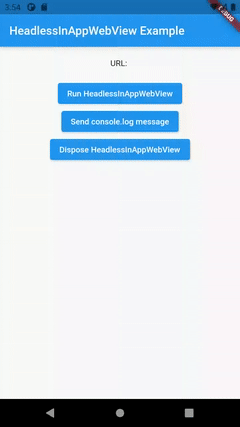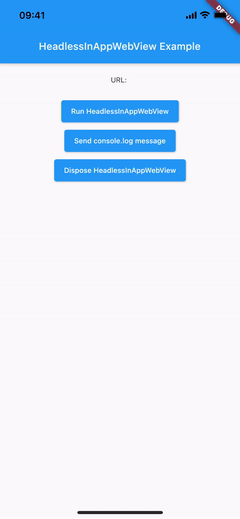Headless InAppWebView
The HeadlessInAppWebView class represents a WebView in headless mode.
It can be used to run a WebView in background without attaching an InAppWebView to the widget tree.
Basic Usage
As InAppWebView, it has the same options and events. Use InAppWebViewController to control the WebView instance.
Remember to dispose it when you don't need it anymore using the HeadlessInAppWebView.dispose method.
The initial width and height of the Headless WebView will match the device screen size, and it is represented by Size(-1, -1).
If you need to define a different initial size, you can use the initialSize property, for example initialSize: Size(600, 800).
To get the current size, you can use the HeadlessInAppWebView.getSize method.
Instead, if you need to change the current size, you can use the HeadlessInAppWebView.setSize method.
Note that if the HeadlessInAppWebView is not running, the getSize method will return null and setSize method won't have effect.
Example:
import 'dart:async';
import 'dart:io';
import 'package:flutter/material.dart';
import 'package:flutter_inappwebview/flutter_inappwebview.dart';
Future main() async {
WidgetsFlutterBinding.ensureInitialized();
if (Platform.isAndroid) {
await AndroidInAppWebViewController.setWebContentsDebuggingEnabled(true);
}
runApp(MaterialApp(home: new MyApp()));
}
class MyApp extends StatefulWidget {
_MyAppState createState() => new _MyAppState();
}
class _MyAppState extends State<MyApp> {
HeadlessInAppWebView? headlessWebView;
String url = "";
void initState() {
super.initState();
headlessWebView = new HeadlessInAppWebView(
initialUrlRequest:
URLRequest(url: Uri.parse("https://github.com/flutter")),
onWebViewCreated: (controller) {
final snackBar = SnackBar(
content: Text('HeadlessInAppWebView created!'),
duration: Duration(seconds: 1),
);
ScaffoldMessenger.of(context).showSnackBar(snackBar);
},
onConsoleMessage: (controller, consoleMessage) {
final snackBar = SnackBar(
content: Text('Console Message: ${consoleMessage.message}'),
duration: Duration(seconds: 1),
);
ScaffoldMessenger.of(context).showSnackBar(snackBar);
},
onLoadStart: (controller, url) async {
final snackBar = SnackBar(
content: Text('onLoadStart $url'),
duration: Duration(seconds: 1),
);
ScaffoldMessenger.of(context).showSnackBar(snackBar);
setState(() {
this.url = url?.toString() ?? '';
});
},
onLoadStop: (controller, url) async {
final snackBar = SnackBar(
content: Text('onLoadStop $url'),
duration: Duration(seconds: 1),
);
ScaffoldMessenger.of(context).showSnackBar(snackBar);
setState(() {
this.url = url?.toString() ?? '';
});
},
);
}
void dispose() {
super.dispose();
headlessWebView?.dispose();
}
Widget build(BuildContext context) {
return Scaffold(
appBar: AppBar(
title: Text(
"HeadlessInAppWebView Example",
)),
body: SafeArea(
child: Column(children: <Widget>[
Container(
padding: EdgeInsets.all(20.0),
child: Text(
"URL: ${(url.length > 50) ? url.substring(0, 50) + "..." : url}"),
),
Center(
child: ElevatedButton(
onPressed: () async {
await headlessWebView?.dispose();
await headlessWebView?.run();
},
child: Text("Run HeadlessInAppWebView")),
),
Center(
child: ElevatedButton(
onPressed: () async {
if (headlessWebView?.isRunning() ?? false) {
await headlessWebView?.webViewController.evaluateJavascript(
source: "console.log('Here is the message!');");
} else {
final snackBar = SnackBar(
content: Text(
'HeadlessInAppWebView is not running. Click on "Run HeadlessInAppWebView"!'),
duration: Duration(milliseconds: 1500),
);
ScaffoldMessenger.of(context).showSnackBar(snackBar);
}
},
child: Text("Send console.log message")),
),
Center(
child: ElevatedButton(
onPressed: () {
headlessWebView?.dispose();
setState(() {
this.url = '';
});
},
child: Text("Dispose HeadlessInAppWebView")),
)
])));
}
}
This is the result:
- Android
- iOS


Did you find it useful? Consider making a donation to support this project and leave a star on GitHub 